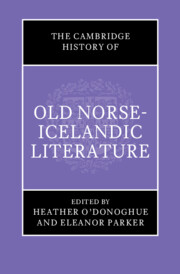Book contents
- The Cambridge History of Old Norse-Icelandic Literature
- The Cambridge History of Old Norse-Icelandic Literature
- Copyright page
- Contents
- Contributors
- Abbreviations
- Introduction
- Part I Contexts
- Part II The Distant Past
- Part III The Saga Age
- Part IV The New Christian World
- PART V Beyond Iceland
- Part VI Compilations
- 23 The Prose Edda
- 24 Samtíðarsögur
- 25 Learned Literature
- 26 Grágás and the Legal Culture of Commonwealth Iceland
- Glossary
- Bibliography
- Index
25 - Learned Literature
from Part VI - Compilations
Published online by Cambridge University Press: 08 February 2024
- The Cambridge History of Old Norse-Icelandic Literature
- The Cambridge History of Old Norse-Icelandic Literature
- Copyright page
- Contents
- Contributors
- Abbreviations
- Introduction
- Part I Contexts
- Part II The Distant Past
- Part III The Saga Age
- Part IV The New Christian World
- PART V Beyond Iceland
- Part VI Compilations
- 23 The Prose Edda
- 24 Samtíðarsögur
- 25 Learned Literature
- 26 Grágás and the Legal Culture of Commonwealth Iceland
- Glossary
- Bibliography
- Index
Summary
This chapter discusses the interactions between Latin learning and Old Norse-Icelandic vernacular literature between the twelfth and fourteenth centuries. Beginning with the arrival of Latin textual culture in Iceland with the introduction of Christianity, it describes how oral literary culture was transformed by contact with these new forms of learning. It takes as case-studies manuscripts which reveal the influence of learned material, first considering the relationship between Ari’s Íslendingabók and the study of computus, chronology and geographical learning, and then discussing encyclopaedic handbooks attributed to two lawmen, Sturla Þórðarson’s Resensbók and Haukr Erlendsson’s Hauksbók. To explore the interaction between Latin learning and skaldic poetry, it then focuses on Codex Wormianus, a compilation of vernacular grammatical literature and skaldic poetics. It argues that skaldic verse was reconciled with Christian textual culture by functioning in vernacular grammatical literature in the same way as classical verse did in Latin culture, and analyses an example from the Third Grammatical Treatise to show how a skaldic stanza could be used in this way.
Keywords
- Type
- Chapter
- Information
- The Cambridge History of Old Norse-Icelandic Literature , pp. 518 - 536Publisher: Cambridge University PressPrint publication year: 2024

